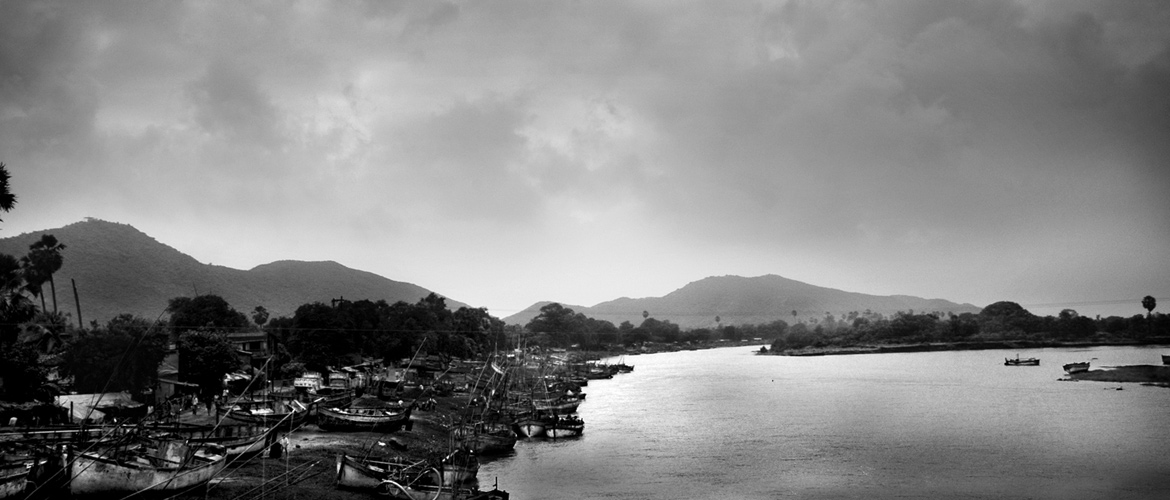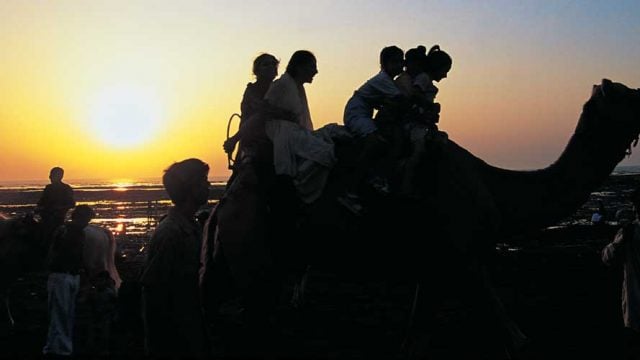It’s unlikely that you’ll spend time deciding where to go in Daman and how, for the whole
Things to See & Do
A good way to explore Daman is to start with the Damanganga River, which divides it into Nani Daman and Moti Daman (the side populated by the Portuguese). Legend has it that it’s impossible to connect the two banks of the river. Locals claim the Portuguese tried to build a bridge in the 1930s, but it was washed away in the monsoons. The bridges built thereafter met the same fate. The last one, inaugurated in 1993, collapsed in 2003 and the one that came up in its place was washed away in 2004!
Looking at the Damanganga River, flowing along the picturesque quay, it is impossible to imagine that it was not only a major harbour once, but also a major ship-building hub. It is said that 500-600 tonne ships were built here out of Daman’s rich reserve of teak forests. The river is fortified with two forts at the mouth of the river. To the north lies Fort St Jerome at Nani Daman and to the south, Fort Hieronymus at Moti Daman.

Moti Daman
The Hieronymus Fort was built on the site of an earlier fort in 1593, which belonged to Bahadur Shah, the Sultan of Gujarat. The fort is encircled by a moss-covered moat. The Portuguese Lighthouse, which has now been replaced by a modern structure, towers above the fort. The northern side of the fort housed palaces, administrative buildings and churches. Of these, the Governor’s Palace and the Collectorate are said to have been built in the place of Abyssinian structures. Equip yourself with a map from the Nani Daman Tourist Office The most appealing historical aspects of the fort are the many churches, chapels and monasteries. The Dominican Seminary, even in its ruined state, offers a glimpse of old Daman. Its ceiling evokes images of heaven; the floral carvings in the central hallway are today guarded by the ASI. The 16th-century Church of Our Lady of Remedios, en route the main entrance of the fort, is also outstanding for its part-Gothic, part-Byzantine woodwork figurines. But the main attraction within the Chapel Square is the Church of Bom Jesus (1605). This gilded wonder of bricks and wood, also known as Sé Cathedral, has an impressive altar. The Easter procession in Daman stops at every chapel in the city, starting with the 16th-century chapel of Our Lady of Rosary— also known as Madre Di Dios — where a handcrafted wooden altar depicts the various stages of Virgin Mary’s life. Visit the intricately carved chapel of St Augustus, built in the memory of soldiers who died in the First World War. The Main Street (rebuilt in 1886 after a devastating storm) has a 4-foottall cross, carved from a single block of wood. Opposite the Sé Cathedral stands the jailhouse, where prisoners of the Inquisition were held. There’s a 24-hr ferry service to Moti Daman from Nani Daman Jetty
Ferry fare ₹5-10

Nani Daman
The Fort of St Jerome at Nani Daman requires a day’s trip. The fort was built between 1614 and 1627 and is badly maintained. The chapel within the fort is dedicated to Our Lady of the Sea and has an altar carved in rosewood; one can also see gold filigree work. The graveyard here has some exquisite marble figurines.
And a temple
Hindu Daman has its own identity in the shape of Somnath Temple, which is near the large industrial estate of Dabhol. This much-renovated temple is worth a visit for the exquisite Kutchi glasswork that decorates both the ceiling and the floor.
Shopping
Nani Daman, tiny as it is, has one main street that runs in its middle, towards the sea, where you’ll find all that’s available in Daman on sale. Makeshift stores line the Seaface Road offering smuggled clothes at unbelievable prices. Cradled next to the clothes store, you’ll find — noM prizes for guessing — liquor stores. Just remember that it’s illegal to take alcohol out of Daman. The 200-year-old Mercardo Municipal (rebuilt
sometime in the 1940s), along the same stretch, is a cluster of little stores that stock everything from footwear and vegetable choppers to ‘designer’ watches. Just before the municipal market and next to the police station, you’ll find a tiny dollar shop selling plastic goods.\
Where to Stay
If you’re here on a historical tour, Hotel Marina (Tel: 0260-2254420; Tariff: ₹1,125), behind the police station at Nani Daman, is a 140-year-old Portuguese homestead and is the closest you will get to a bed-and-breakfast in Daman. The antique furniture in the home and the lovely courtyard will give you a glimpse of Daman’s history. The centrally located Hotel Gurukripa (Tel: 2255046, 2250227; Tariff: ₹1,350-1,890), on Seaface Road, is ideal for those wishing to access Nani Daman on foot. It offers good food, comfortable rooms and excellent room service. Hotel Dariya Darshan (Tel: 2254476; Tariff: ₹1,500-4,400) at Devka Beach arranges taxis. Hotel Cidade de Daman (Tel: 2250590-91; Tariff: ₹2,500-3,500), also on Devka Beach, is the closest to a 5-star hotel in Daman. Hotel Miramar (Tel: 2250671- 73; Tariff: ₹3,000-7,500), also on Devka Beach Road, is a place that’s always packed, so reserve in advance. Another popular stay option is Hotel Shilton (Tel: 2254407; Tariff: ₹1,200- 2,000), with 26 rooms, on Devka Beach.
Where to Eat
Daman’s food is part Goan (though Damanese claim their bebinca is more authentic) and part Gujarati. But all differences vanish at the dinner table, where the Gujarati thali meets the tangy fish curry and a beetroot wine clinks alongside a hearty beer. Visitors to Daman usually head to Gurukripa, situated half-way between Moti Daman and Devka Beach, to taste Daman’s rich variety of seafood —from Goan fish curry and rice to Damanese specialities like chicken xacuti, dhara fish fry, butter-garlic tiger prawns and fried squid. Hotel Sovereign, a sister concern that’s a few buildings down the block, specialises in vegetarian dishes. Nearby is the Pithora Garden restaurant recreating a village ambience. The Miramar Water Park, restaurant-cumcafé at the other end of Nani Daman, overlooks the lake, where you can take a pre- or post-dinner paddle in a boat. Duke’s, Daman’s oldest restaurant (started in the 1940s), run by a Parsi family, is famous for its breakfast of sausages and scrambled eggs.
AROUND DAMAN
Dadra and Nagar Haveli The 70-odd villages located here offer the visitor an insight into local tribal wonders. Watch those Tarpa dancers tap dance their feet off on moonlit nights, and if that’s not enough, marvel at the colours and rhythm of the Bhawara mask dance. Hotel Ras Resorts (Tel: 0260-2640373; Tariff: ₹5,500-6,500) arranges tribal village tours and cultural nights. The capital Silvassa (47 km from Daman) has a tribal museum. For a fun boat trip, head to the Vanganga Lake here.
Name The word Daman is a corruption of Portuguese word Damao
Age Though its age is unknown, it’s said to have existed during the same time as the Bassein Port, which in turn traces its origins to 9 CE. In the 16th century, prior to its capture by the Portuguese, Daman was a part of the Gujarat Sultanate
Union Territory of Daman and Diu
Location This tiny Indo-Portuguese enclave is tucked between Maharashtra and Gujarat just north of the interstate border on the West Coast of India, 10 km from Vapi
Distances 195 km N of Mumbai, 378 km S of Ahmedabad
Route from Mumbai NH8 to Vapi Junction via Manor and Talasari; state road to Daman via Vapi
Daman and Diu
Moti Daman
Nani Daman



